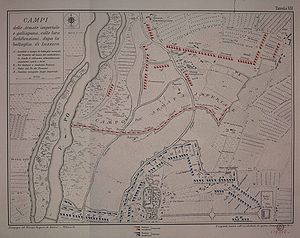Battle of Luzzara
| date | August 15, 1702 |
|---|---|
| place | Luzzara |
| output | draw |
| Parties to the conflict | |
|---|---|
| Commander | |
| Troop strength | |
| 38 battalions of infantry, 80 squadrons of cavalry, 57 guns, a total of 25,000 men | 49 battalions of infantry, 103 squadrons of cavalry, no number of guns altogether 30,000 men |
| losses | |
|
about 2700 men |
about 3500 men |
Carpi - Chiari - Cremona - Kaiserswerth - Luzzara - Cádiz - Friedlingen - Vigo - Schmidmühlen - Ekeren - Höchstädt (1703) - Gibraltar - Speyerbach - Schellenberg - Bonn - Höchstädt (1704) - Vélez-Málaga - Cassano - Barcelona (1705) - Sendlinger Murder Christmas - Calcinato - Ramillies - Turin - Castiglione - Almansa - Toulon - Lille - Oudenaarde - Malplaquet - Almenara - Saragossa - Brihuega - Villaviciosa - Denain - Rio de Janeiro - Barcelona
The Battle of Luzzara took place on August 15, 1702 during the War of the Spanish Succession . The imperial troops under Eugene of Savoy faced a Franco-Spanish army under Louis II Joseph de Bourbon, duc de Vendôme and King Philip V of Spain . The battle ended without a definite victory.
prehistory
After the defeat of the imperial troops at St. Vittoria against the French troops under Louis II. Joseph de Bourbon, duc de Vendôme, the imperial commander-in-chief in Italy Eugene of Savoy had to break off the siege of Mantua that had previously started . He now wanted to militarily cover the area around Modena and Morandola and was ready to risk a major battle for it.
This was a considerable risk, as he only had about 25,000 men. The combined army of Spanish and French units, on the other hand, was 30,000 to 35,000 men strong. This was commanded by Vendome and Philip V of Spain.
In addition to the main army, Eugene of Savoy also occupied the towns of Bresello , Borgoforte , Ostiglia , Guastalla and Luzzara. In Luzzara there was a ship bridge over the Po . The conquest of the river crossing was the goal of the Spanish-French army and this advanced on the morning of August 15th.
The vanguard commanded by Vendome consisted of 24 companies of grenadiers and a few cavalry regiments. The main Spanish-French power followed in two columns. The right was commanded by Philip V and the left by Count Teffe. When the French vanguard arrived at Luzzara around 8 o'clock, Vendome asked the Austrian local commandant to hand over the place. However, he had orders to defend Luzzara to the last man, had the French shot and withdrew with his troops into a tower, which was then surrounded by the opposing army. The French-Spanish army set up camp on the other side of the town.
Prince Eugene had learned of the events in Luzzara through spies and wanted to fight the enemy there. He hoped that the enemy would be taken by surprise. With his army he crossed the Po without being noticed. Protected by a large dam, which was used to protect against flooding, the imperial troops could get close to the Franco-Spanish army. The Austrians were discovered by chance.
course
Thereupon the French army broke off the construction of the camp and formed in a hurry. Vendome set up two corps of infantry and cavalry on both wings. On the embankment he posted an artillery battery.
Eugene also raised his troops. The right wing of the imperial was commanded by Charles of Lorraine-Commercy . The infantry crossed a canal and climbed over the dam. Extra breakthroughs were made for the cavalry. The Prince of Commercy began the attack on the right wing. The terrain in front of his troops was very unfavorable due to numerous hedges and trenches. The cavalry could hardly be used. The left Spanish-French wing marched against the Imperialists. At a short distance, both sides fired their first volleys.
After Commercy fell, the Imperial forces began to retreat. They could be collected again and, under Eugen's orders, they succeeded in driving the enemy out of the area of the hedges and ditches. The imperial troops were temporarily driven back before they gained the upper hand here. On the left wing of the imperial, commanded by Guido von Starhemberg , the latter also had an attack. On the Franco-Spanish side, the infantry faced the entire heavy cavalry and various dismounted dragoon regiments. Starhemberg's first attack failed. After he had gathered his units, reinforced by cuirassiers and dragoons, he let go of the attack again. The French cavalry was defeated, and the Spanish-French infantry tottered, dragging the middle with them.
Despite all attempts, the Duke of Vendome did not succeed in regaining the lost ground. The fighting continued during the night. But the imperial family did not succeed in advancing either. The battle ended late in the night as a result of the exhaustion of both armies. Both armies encamped on the battlefield. Prince Eugene holed up because he expected the fighting to continue the next morning, which, however, did not happen.
consequences
Both sides credited the victory in the episode. The imperial ones were able to hold their own, but could not horror Guastalla. The information about the losses vary among the various authors. The number of wounded on the Franco-Spanish side was higher than among the imperial ones.
literature
- Hanns Eggert Willibald von der Lühe (Hrsg.): Militair Conversations-Lexikon. Volume 4: J, K and L. Wigand, Leipzig 1834, pp. 788-790.
Individual evidence
- ↑ Here was used: Gaston Bodart (Hrsg.): Military-historical War Lexicon. (1618-1905). Stern, Wien et al. 1908, p. 127.

